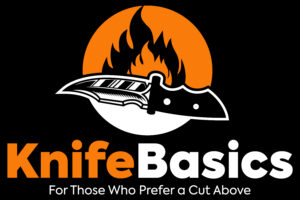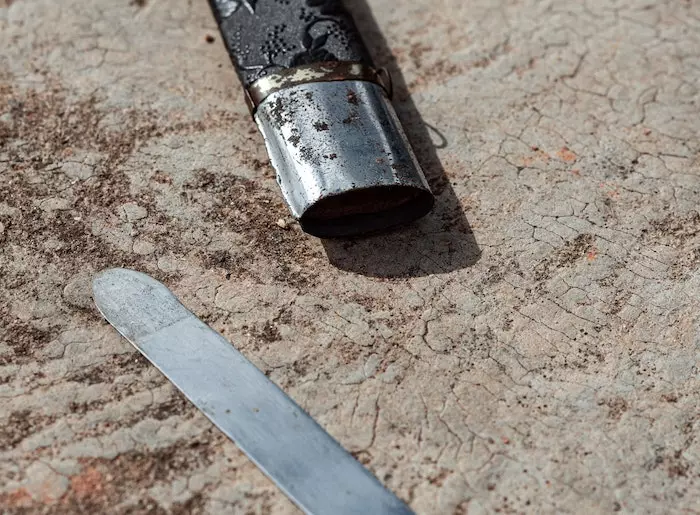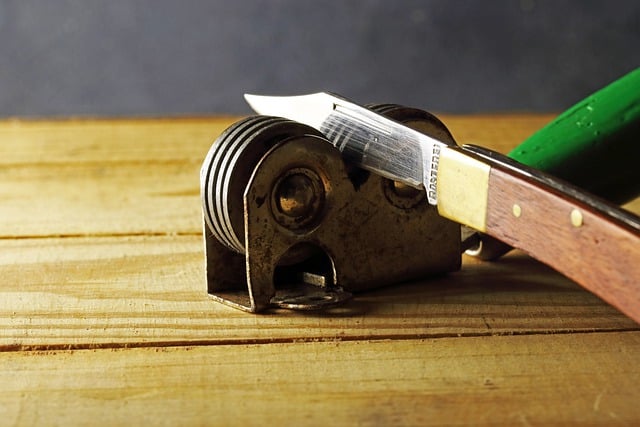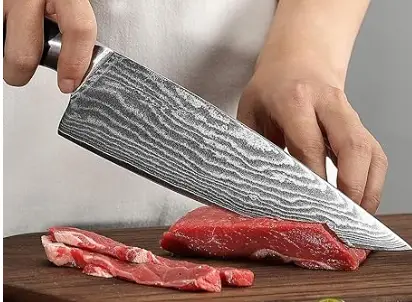What is 5160 steel?
5160 steel, also referred to as AISI 5160 or 5160 spring steel, it is a low-end alloy that contains high carbon with fair amounts of chromium in its composition.
Due to its carbon content and chemical composition, 5160 alloy steel offers outstanding toughness making it tougher than most stainless steel knives. However, 5160 steel is not as hard compared to other types of high-carbon steel.
In addition to the toughness, this steel offers decent hardness and high ductility, making it possible to make a large knife from it.
Knifemakers mostly use 5160 carbon steel to manufacture knives used in demanding applications like survival knives, camping knives, modern-day swords, and long knives.
5160 Steel Composition
| Element | Percentage composition | Function |
|---|---|---|
| Carbon C | 0.56%-0.64% | Increases edge retention, hardness, and tensile strength. It also improves steel resistance to wear, abrasion, and corrosion. |
| Chromium Cr | 0.70%-0.90% | The formation of Chromium carbide Increases the hardness, tensile strength, and corrosion resistance of the blade. |
| Manganese Mn | 0.75%-1.00% | Improves the strength and hardness of steel. When the steel is heat-treated, hardenability is improved with increased manganese. |
| Silicon Si | 0.15%-0.30% | Increases strength and heat resistance. |
| Sulfur S | 0.04% | Improves machinability but is regarded as an impurity in high quantities. |
| Phosphorus P | 0.035% | Improves machinability and hardness, but is regarded as an impurity in high quantities. |
5160 Steel Properties
Hardness
5160 steel hardness is 57-58 HRC as per Rockwell hardness. Its hardness greatly depends on the tempering stage, optimal temperature during heat treating as specified by the manufacturer will yield hard steel.
With a hardness of 58 HRC, A 5160 high carbon steel knife will have good edge retention and good toughness properties. However, it is not as hard as other carbon steel, which is not that bad since it is tougher and easier to sharpen than its counterparts.
Toughness
5160 spring steel offers excellent toughness, which is made possible by the relatively low carbide percentage in its composition compared to other carbon steels.
Knives made with 5160 spring steel are great for camping and other outdoor applications because it performs hard tasks like batoning and wood chopping without breaking, chipping, or losing their shape.
Wear resistance
With the low carbon amounts in its composition, you cannot expect excellent wear resistance from this steel.
However, it gives you decent wear resistance compared to other soft steels. 5160 knife steels will serve you for long, even with regular usage and sharpening.
Edge retention
Another feature affected by the low carbon content of 5160 steel is its edge retention. It gives you fairly good edge retention meaning that it does not hold an edge long enough.
When taking home a 5160 steel knife, have it registered at the back of your mind that it will require frequent sharpening.
Corrosion resistance
5160 high carbon performs poorly in corrosion resistance because of the low amounts of chromium in its composition. Without proper care, this steel rusts in no time, even in normal conditions.
However, hope is not lost for knives made from this steel because you can keep them rust-free by ensuring that they are stored clean and dry. For better protection against rust, apply a coat of lubricant or oil after drying.
Sharpening
5160 high carbon steel is easy to sharpen, this is attributed to low chromium and carbon contents in its composition.
You might have noticed that all high-end stainless steel knives are difficult to sharpen, this is because they contain high levels of carbon and chromium.
With soft steel like AISI 5160 steel, you can easily get an edge without much effort and time. This feature comes in handy since this steel becomes dull faster. The fact that you can get an edge more quickly makes frequent sharpening manageable.
5160 equivalent
52100 steel and 65Mn steel are 5160 steel equivalent in terms of performance aspects such as toughness, edge retention, and corrosion resistance. The difference in toughness and edge retention between these blade steels is negligible, they offer very poor corrosion resistance.
5160 vs 420HC Steel
| 5160 steel | 420HC steel | |
|---|---|---|
| Toughness | 9.5/10 | 9/10 |
| Edge Retention | 1.5/10 | 2.5/10 |
| Corrosion Resistance | 0.5/10 | 8/10 |
420HC steel is better than 5160 steel in corrosion resistance as it is stainless steel with over 13% chromium content while 5160 steel is non-stainless steel with 0.90% chromium content. 420HC steel blades thus offer better rust resistance than 5160 blades.
Both 5160 and 420HC perform poorly in edge retention, but 420HC steel holds an edge slightly better than 5160 steel. 5160 knife steel is, however, easier to sharpen compared to sharpening 420HC and this can be attributed to the lower hard carbide content.
5160 carbon steel offer slightly better toughness than 420HC stainless steel and is a preferred choice for most bladesmith as it is easy to forge and machine. Its toughness also makes it a good choice for swords and katanas.
5160 steel vs S30V
| 5160 steel | S30V steel | |
|---|---|---|
| Toughness | 9.5/10 | 4/10 |
| Edge Retention | 1.5/10 | 6/10 |
| Corrosion Resistance | 0.5/10 | 7.5/10 |
S30V steel is stainless steel with 14% chromium content, it offers better corrosion resistance than 5160 knife steel. S30V steel has higher carbon content at 1.48% compared to 5160 steel’s 0.56%. This carbon element gives it higher hardness and wear resistance while enhancing its edge retention properties.
S30V steel is a powder metallurgy steel with better alloy composition and better performance than 5160 carbon steel. S30V steel is thus suitable for most knives due to its balanced performance aspects in terms of edge retention, corrosion resistance, and toughness.
5160 carbon steel offers better toughness than S30V steel, it is thus less likely to chip or break on impact. 5160 steel is thus suitable for long blades like swords and katanas while S30V steel is most suitable for smaller blades like pocket knives where edge retention and corrosion resistance are most preferred.
5160 steel vs D2
| 5160 steel | D2 steel | |
|---|---|---|
| Toughness | 9.5/10 | 3.5/10 |
| Edge Retention | 1.5/10 | 5/10 |
| Corrosion Resistance | 0.5/10 | 4.5/10 |
D2 steel is semi-stainless steel with 12% chromium content, it offers better corrosion resistance than 5160 carbon steel which contains 0.9% chromium content. Additionally, D2 steel contains more carbon content than 5160 which enables D2 blades to achieve better edge retention and wear resistance than 516o blades.
5160 steel on the other hand offers better toughness than D2 steel. The toughness of 5160 knife steel is suitable for long blades like Katanas, swords, and tough blades like kukris. D2 is suitable for pocket knives due to its incredible edge retention and enhanced corrosion resistance.
Is 5160 steel good for knives?
However, if you are after a knife with outstanding corrosion, stain resistance and edge retention 5160 alloy steel varieties will not be a good choice for you.
Is 5160 steel good for swords?
Conclusion
5160 alloy steel is an admired steel for its toughness by knife makers and users alike. It was originally made for leaf spring but found love in knife making and became reputable knife steel.
However, like many other carbon steel alloys with low chromium content, it needs care and maintenance to avoid corrosion and rust. Applying mineral oil will prevent oxidation if the knife is to be left sitting for a long time.



